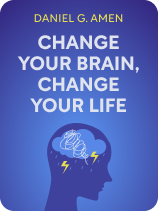

This article is an excerpt from the Shortform book guide to "Change Your Brain, Change Your Life" by Daniel G. Amen. Shortform has the world's best summaries and analyses of books you should be reading.
Like this article? Sign up for a free trial here.
How does your brain health impact your overall health? What are the best ways to take care of your brain?
In his book Change Your Brain, Change Your Life, Daniel G. Amen asserts that, even if your brain’s health has been compromised, it has the potential for recovery and rejuvenation. Alongside insights gained from cutting-edge brain scans, he provides practical strategies for optimizing your brain’s health.
Continue reading for an overview of Dr. Amen’s book Change Your Brain, Change Your Life.
Overview of Dr. Amen’s Book Change Your Brain, Change Your Life
Daniel G. Amen is a psychiatrist and brain health expert with 30 years of patient experience. Dr. Amen’s book Change Your Brain, Change Your Life offers a new, more effective approach to treating and overcoming physical, mental, and cognitive issues.
Amen’s approach is informed by SPECT (single photon emission computed tomography) scans—a type of brain imaging that shows a brain’s blood flow and electrical activity. Through these scans, Amen found that he could identify a wide range of indicators of poor brain health, including physical trauma, toxin exposure, infections, inadequate neural stimulation, and unbalanced neurotransmitters (chemical messengers that regulate mood and cognition). He noticed that certain brain patterns seemed to be associated with particular health conditions.
Amen realized that many people’s physical, mental, and cognitive issues arise from physical damage to specific regions of the brain and their associated functions. However, traditional medical approaches don’t take this into account: Practitioners typically observe and make diagnoses based on the external expression, or symptoms, of these underlying physical damages. As a result, patients’ issues may be misdiagnosed and they may receive inadequate treatments.
Amen asserts that the most effective way to provide long-term relief for many health issues is to treat them at the root by repairing physical damage to your brain and enhancing its overall health. We’ll explore his suggested treatments for achieving this in two parts:
- In Part 1, we’ll explain how nurturing four factors—biological health, psychological well-being, social interactions, and spiritual fulfillment—contributes to brain health.
- In Part 2, we’ll explore the unique functions of each of the brain’s five regions, pinpoint symptoms that indicate an underlying dysfunction, and provide advice for healing and optimizing performance across these five regions.
Part 1: Adopt a Holistic Approach to Brain Health
While Amen advocates using SPECT scans to diagnose the biological underpinnings of mental health conditions, he emphasizes that effective treatment plans require a holistic approach that addresses biological, psychological, social, and spiritual factors. He explains that these four factors interdependently influence your overall health—and, by extension, your brain health and function. For example, lack of sleep (biological) can alter your brain chemistry and cause anxiety (psychological), leading to social withdrawal (social) and a diminished sense of purpose (spiritual).
Amen suggests that even without a SPECT scan and targeted treatment for your brain’s particular issues, you can still substantially improve your brain health by nurturing these four factors. Let’s explore his advice in detail.
Factor #1: Biological Health
The first factor influencing your brain’s health is your biological health, encompassing your overall physical condition. Amen provides four suggestions for enhancing your biological health and explains how each benefits your brain.
1)Nourish your body: Consume a well-balanced diet rich in essential nutrients like omega-3 fatty acids and antioxidants to promote efficient communication between brain cells and to balance neurotransmitter levels.
2) Elevate your activity level: Amen recommends regular exercise, including aerobic and strength training, to increase blood flow to the brain and stimulate the growth of new brain cells.
3) Prioritize quality sleep: Amen says that ensuring you get sufficient, high-quality sleep facilitates essential brain maintenance activities that require deeper stages of sleep—such as memory consolidation, emotional regulation, and the removal of waste products from your brain.
4) Safeguard against threats: Amen advises you to remain vigilant to potential threats like physical trauma (for example, a blow to the head), exposure to toxins (such as lead in paint or pesticides), illness, or infections, all of which can harm your physical well-being and your brain’s health.
Factor #2: Psychological Well-Being
The second factor influencing your brain’s health is your psychological well-being, encompassing your thought patterns, self-perception, and self-esteem. Amen suggests three tips for nurturing your psychological health and describes how each improves your brain function.
1) Exercise your mind: Challenge your brain with intellectually stimulating activities such as chess and card games to promote the growth of new brain cells and preserve cognitive function.
2) Manage stress effectively: Amen advises developing a stress-management program that includes mindfulness techniques, deep breathing exercises, and journaling. This prevents chronic stress from harming your brain cells.
3) Seek mental health support: Consult qualified mental health professionals to address and manage mental health concerns such as anxiety from past traumas. Getting a handle on these issues helps maintain your capacity for rational thinking.
Factor #3: Social Interactions
The third factor influencing your brain’s health is your social interactions, encompassing the relationships, communication, and connections you have with others. Amen suggests that nurturing relationships with friends, family, and peers helps your brain stay active and engaged, reduces stress, and provides emotional support, all of which are crucial for brain health.
Amen adds that your brain will benefit even more if you build relationships with individuals who prioritize wellness, as their habits and support can positively influence your lifestyle.
Factor #4: Spiritual Fulfillment
The fourth factor influencing your brain’s health is your spiritual fulfillment, encompassing your sense of life’s purpose and meaning. Amen identifies two methods for tending to your spiritual fulfillment and outlines how each positively affects your brain.
1) Contemplate profound questions: Reflect on your values, beliefs, and connections to the world. This practice stimulates neural pathways (information-transmitting networks in your brain) related to self-awareness and emotional well-being, contributing to optimal brain health.
2) Engage in spiritual activities: Amen recommends practices such as meditation, prayer, or volunteer work to foster rational thinking and mental flexibility. These activities help to relieve stress and broaden your perspective on life, countering the impact of ruminative thoughts that might otherwise entangle you in self-defeating patterns.
Part 2: Repair and Optimize Each of Your Brain’s Five Regions
Now that we’ve explained how nurturing four factors can improve your overall health and, by extension, your brain health, let’s delve deeper into the brain itself to target specific issues you may have.
According to Amen, the brain has five main regions, each playing a unique role in how you function: the limbic system, the basal ganglia, the prefrontal cortex, the anterior cingulate gyrus (ACG), and the temporal lobes. He explains that damage or dysfunction in any of these regions can lead to their own set of specific symptoms.
Just as with improving overall well-being and brain health, overcoming these symptoms requires a holistic approach: Amen recommends a range of biological, psychological, social, and spiritual treatments to repair and optimize each brain region. We’ll explore the functions of each of these regions, potential symptoms resulting from dysfunction, and Amen’s targeted treatments and strategies for healing each region so that it can function at its best.
Brain Region #1: The Limbic System
According to Amen, the limbic system plays a pivotal role in forming and consolidating your emotional responses and memories—for example, recalling the warmth of a hug or feeling motivated by a rewarding task. Your limbic system does this by:
- Regulating emotions: It plays a pivotal role in how you experience and express emotions.
- Forming memories: It helps you form and consolidate long-term memories, influencing how you recall past events and experiences.
- Guiding behavior: It influences your responses to emotional stimuli, shaping how you react in different situations.
- Generating motivation: It moderates feelings of motivation, reward, and pleasure, impacting your behavior and decision-making.
- Fostering social bonds: It facilitates emotional connections with others.
- Modulating physiological functions: It regulates appetite, sleep cycles, and libido.
- Processing sensory information: It directly processes your sense of smell, contributing to your perception and response to scents in your environment.
Symptoms of Limbic System Dysfunction
If you find yourself overwhelmed with persistent sadness, perceiving the world through a bleak and colorless lens, you may be experiencing limbic system dysfunction. These symptoms align with the telltale characteristics Amen describes, including:
- Emotional distress: feelings of sadness, excessive guilt, or crying spells
- Lack of vitality and interest: low energy levels, appetite and sleep problems, fluctuations in sexual responsiveness, and a tendency toward social isolation
- Negative self-perception: low self-confidence and heightened sensitivity to criticism
- Cognitive struggles: memory lapses and issues with concentration
- Sensory sensitivity: heightened adverse response to odors
Repair and Optimize Your Limbic System
Amen’s suggestions for repairing and optimizing your limbic system region include the following treatments:
Aromatherapy: Diffusing pleasing fragrances to relieve stress and promote emotional well-being calms the limbic system.
Acupuncture: Inserting fine needles into specific points on the body can increase blood flow to the brain and help regulate your mood, thus contributing to limbic system balance.
Repetitive transcranial magnetic stimulation (rTMS): Administering magnetic pulses to stimulate and optimize brain activity patterns, including those in the limbic system, can improve emotional stability.
Cranial electric stimulation (CES): Applying low electrical currents to enhance mood and improve emotional regulation can potentially influence limbic system functioning.
Neurofeedback: Using real-time monitoring of brain-wave activity to help control the brain’s electrical patterns and optimize emotional balance can potentially benefit the limbic system.
Brain Region #2: The Basal Ganglia
According to Amen, your basal ganglia modulate your reactions and behaviors. For example, when you jump with excitement at good news, or your hands tremble in nervous anticipation, it’s your basal ganglia integrating your feelings and movements. Your basal ganglia achieve this by:
- Coordinating motor control and inhibiting unwanted behaviors: They oversee voluntary movements, integrate feelings, and suppress undesired actions.
- Enhancing cognition: They contribute to decision-making, planning, and problem-solving.
- Regulating emotions and anxiety levels: They aid in emotional processing and mood regulation while helping set appropriate anxiety levels.
- Influencing motivation and reward responses: They direct the brain’s reward system— amplifying motivation, pleasure, and the anticipation of rewards.
- Supporting habit development: They enable the efficient learning and repetition of specific behaviors.
Symptoms of Basal Ganglia Dysfunction
If you constantly feel anxious and nervous, predicting the worst in every situation, your basal ganglia might be damaged. These signs align with specific issues Amen details, including:
- Emotional and psychological issues—heightened anxiety, muscle tension, easily triggered startle responses, reduced confidence, excessive fear of judgment, sensitivity to criticism, a tendency to freeze and avoid conflict, and compulsive habits like nail-biting
- Cognitive and fine motor impairments—memory lapses, concentration difficulties, tics, and fine motor skill issues, such as poor handwriting
Repair and Optimize Your Basal Ganglia
Amen’s recommendations for repairing and optimizing your basal ganglia region include the following treatments and strategies:
Heart rate variability (HRV) training: Enhancing the beat-to-beat variation in heart rhythm, achieved through techniques like controlled breathing, helps increase the time interval between consecutive heartbeats. This lowers stress levels, improving the basal ganglia’s ability to maintain emotional stability and fine-tune physical movements.
Deep diaphragmatic breathing: Taking slow, deep breaths (inhaling for five seconds, holding in for two, exhaling for five, and holding out for two) improves oxygenation and removes waste products from your brain, enhancing basal ganglia function.
Hand warming visualization: Imagining activities that warm your hands, such as sitting by a warm fire, physically increases hand temperature. This induces a relaxed state that lowers blood pressure, promoting optimal basal ganglia function.
Eye movement desensitization and reprocessing (EMDR): Guiding eye movements to process traumatic memories and reduce their emotional impact helps the basal ganglia maintain emotional balance. This treatment typically requires a trained professional to lead you through the process.
Brain Region #3: The Prefrontal Cortex
According to Amen, the prefrontal cortex oversees your executive functions, enabling the modulation of your behaviors and emotions. Examples of this include when you meticulously plan your day, manage your time efficiently, or connect empathetically with a friend. Your prefrontal cortex enables you to behave this way by:
- Guiding executive functions, behavior, and attention: It directs cognitive processes, such as concentration, decision-making, self-control, coordination, adaptability, time management, critical thinking, communication, and goal-directed attention.
- Regulating emotions and fostering empathy: It enables you to effectively feel and express your emotions and develop empathic connections with others.
Symptoms of Prefrontal Cortex Dysfunction
If you find yourself constantly battling distractibility, struggling with impulsivity, or feeling socially anxious in conversations, your prefrontal cortex might be impaired. These issues are consistent with the symptoms Amen identifies, including:
- Attention, focus, and time management issues—difficulty sustaining attention, impulsivity and procrastination, trouble listening, chronic lateness, and impaired short-term memory
- Social and emotional struggles—mood swings, misperceptions, poor judgments, difficulty expressing emotions and controlling behavior, poor social skills, and social anxiety
Repair and Optimize Your Prefrontal Cortex
Amen’s suggestions for repairing and optimizing your prefrontal cortex region include the following strategies:
Harmonize with Mozart: Amen explains that theta brain-wave activity is linked to increased distractibility and impulsivity. Listening to Mozart reduces this activity, enhancing focus and mood control and contributing to your prefrontal cortex functioning more effectively.
Set daily goals: Recording and pursuing daily objectives steers your thoughts and behaviors and enhances prefrontal cortex functionality.
Envision future consequences: Contemplating the potential outcomes of your decisions trains your prefrontal cortex to consider actions’ long-term repercussions.
Leverage organizational support: Using organizational tools and enlisting help from organized people refines your planning skills and elevates the effectiveness of your prefrontal cortex.
Brain Region #4: The Anterior Cingulate Gyrus
According to Amen, the anterior cingulate gyrus plays a crucial role in mental flexibility and decision-making. For example, it allows you to easily shift your attention from one task to another or adapt smoothly to a new idea. Your anterior cingulate gyrus accomplishes this by:
- Facilitating cognitive flexibility: It promotes the ability to effortlessly shift attention between various topics, ideas, and issues—fostering a versatile and fluid thought process.
- Enhancing error detection and conflict resolution: It serves as a cognitive center for detecting errors and resolving conflicts during decision-making, contributing to improved cognitive functioning.
Symptoms of Anterior Cingulate Gyrus Dysfunction
If you find yourself stuck on negative thoughts or compulsive behaviors, or struggling to adapt to changes in your routine, your anterior cingulate gyrus might be damaged. These symptoms correspond with the traits Amen describes, including:
- Cognitive inflexibility and emotional challenges: excessive worrying, intense emotional reactions to changes or disruptions, difficulty shifting focus or behavior, an inability to recognize alternative solutions, a tendency to hold onto grievances, and perfectionism
- Compulsive behaviors and interactions: obsessive negative thoughts, repetitive behaviors, argumentative tendencies, resistance to cooperation, and addictive behaviors
Repair and Optimize Your Anterior Cingulate Gyrus
Amen’s recommendations for repairing and optimizing your anterior cingulate gyrus (ACG) region include the following strategies:
Interrupt repetitive thoughts: Recognizing and disrupting repetitive thoughts—for example, by snapping a rubber band on your wrist—trains your ACG to promptly identify and disrupt repetitive thought patterns, enhancing its adaptability.
Distract yourself: Becoming aware of when you’re fixated on a thought and deliberately shifting your focus—for example, by engaging in a different activity—trains your ACG to redirect repetitive thoughts, fostering better control.
Generate rational solutions: Recording troubling thoughts, formulating actionable steps to address them, and acknowledging aspects beyond your control train your ACG to effectively manage and rationalize repetitive thoughts.
Seek objective advice: Discussing your recurring thoughts or behaviors with others helps you gain impartial insights that enrich your ACG’s problem-solving capabilities and encourage a balanced perspective.
Brain Region #5: The Temporal Lobes
According to Amen, the temporal lobes are integral to understanding language and recalling memories. For example, they help you interpret the tone of someone’s voice or recognize a familiar face. Your temporal lobes enable you to do this by:
- Processing auditory information: They allow you to hear and understand sounds in your environment.
- Language comprehension and production: They support spoken and written language, helping you communicate effectively.
- Visual perception and recognition: They allow you to see and identify objects, faces, and scenes.
- Memory formation and retrieval: They play a crucial role in forming and recalling long-term memories, affecting how you remember experiences and events.
Symptoms of Temporal Lobe Dysfunction
If you struggle to comprehend spoken words or fail to recognize the faces of loved ones, or often misinterpret the world around you, your temporal lobes might be damaged. These conditions are in line with the characteristics Amen outlines, including:
- Emotional challenges—aggression, negative or violent thoughts, sensitivity to perceived offenses, paranoia, emotional instability, unexplained anxiety or fear, and a tendency to fixate on religious or moral concerns
- Cognitive and language difficulties—word-finding problems, challenges in processing auditory and visual information, memory issues, impaired reading comprehension, periods of absent-mindedness, and a tendency for hypergraphia (excessive writing)
- Sensory and perceptual challenges—abnormal or distorted visual or auditory perceptions, feelings of deja vu, difficulty recognizing known places or individuals, and unexplained headaches or abdominal discomfort
Repair and Optimize Your Temporal Lobes
Amen’s advice for repairing and optimizing your temporal lobes includes the following strategies:
Engage in rhythmic activities: Participating in activities like chanting or dancing helps you enter a trance-like state that fosters tranquility and open-mindedness, promoting a sense of emotional well-being that stimulates and heals the temporal lobes.
Practice toning and humming: Using vocalization techniques helps induce relaxation, release pent-up emotions, and alleviate physical discomfort. These effects enhance mental clarity, thereby aiding the temporal lobes in regulating mood and cognition.
Master anger management: Adopting a five-step approach—focusing on relationship goals, identifying your anger patterns, controlling your breathing, employing distractions, and considering the effects of your anger—helps reduce stress on the temporal lobes.

———End of Preview———
Like what you just read? Read the rest of the world's best book summary and analysis of Daniel G. Amen's "Change Your Brain, Change Your Life" at Shortform.
Here's what you'll find in our full Change Your Brain, Change Your Life summary:
- A more effective approach to overcoming physical, mental, and cognitive issues
- The four factors to nurture to improve your brain health
- Why listening to Mozart can enhance your focus and mood control






